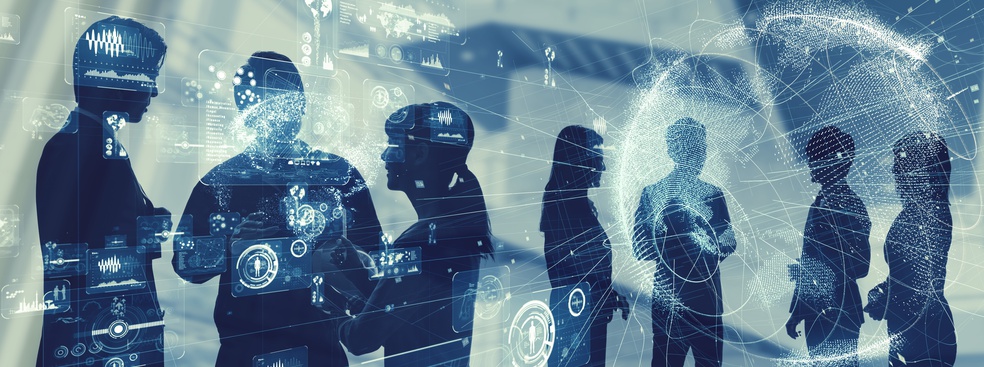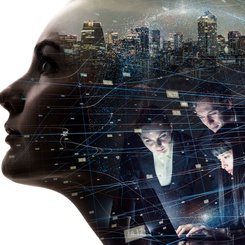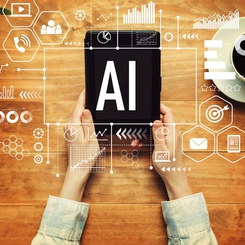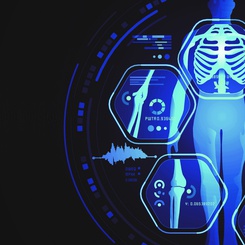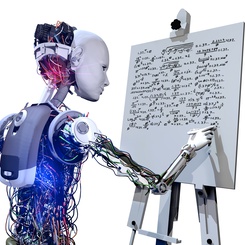The term AI has been around for nearly 70 years, but it is only nowadays that AI is profoundly affecting and changing the way we live, work, interact and play. AI is on an unstoppable journey toward revolutionizing and disrupting diverse industries, and business leaders are embracing this trend with enthusiasm . So, why haven’t we seen the rise of AI much earlier and is AI here to stay this time? Or is AI yet another new technology riding the hype wave? How can AI help us become better decision-makers?
First of all, what is AI?
Many researchers agree with Larry Tesler (a computer scientist who invented copy-paste while working at Xerox and worked on human-machine interaction) that “AI is anything that hasn’t been done yet!”. This means that the definition of AI changes over time. As we get used to previous advances in technology and computer science, what is called AI today, will be regarded as mainstream tomorrow.
Nevertheless, many will agree that, contrary to many “AI winters” that we have experienced in the past, now it is different: the time is ripe and AI is here to stay. This is because of the three major forces that have converged to enable the “AI revolution” we are facing today:
1) Increased processing and storage capabilities: we have seen a one trillion-fold increase in computing power between 1956 and 2015 with the rapidly falling cost of technologies, a trend that is continuing to this day. Nintendo consoles in 1983 are just as powerful as the Apollo Guidance Computer that brought the first humans to the moon in 1969. The 2010 iPhone 4 is just as powerful as the fastest machine in the world in 1985, the Cray-2 supercomputer.
2) Cloud computing: data storage and computing capabilities are now outsourced to the “clouds”. Today, concepts like Infrastructure-as-a-Service (IaaS), Platform-as-a-Service (PaaS) and even Machine-Learning-as-a-Service (MLaaS) are available at affordable prices. They provide low barriers to entry and allow businesses to quickly adopt new IT technologies.
3) Connectivity and availability of real-time data: large swaths of varied and real-time data can be collected instantaneously, thanks to mobile phones, sensors, the IoT and other devices linked to the internet or intranet networks. This enables real-time prediction, prescriptions, automation and coordination of many complex processes.
How can we improve decision making by leveraging (big) data analytics and AI?
You might be excited by the recent technological advances around robotics, self-driving cars, flying taxis, etc. You might be equally terrified of military applications of AI, or of the potential threats related to face recognition or racial profiling. For now, let us focus on a more practical question: how can we improve everyday business practices by leveraging (big) data analytics and AI? This is where AI with Business Analytics (AI+BA), also called “AI-powered analytics”, comes into play.
Business Analytics is the exploration and exploitation of an organization's data, with an emphasis on 1) data analytics, 2) predictions, and 3) prescriptions and decision support. Companies that use BA are committed to making better, more informed and data-driven decisions. BA is applicable across many different sectors: retail, transportation, entertainment, health-care, and energy, to only name a few. BA is a multi-disciplinary approach that combines computer science, statistics, mathematics, decision making and optimization. It allows organizations to eradicate some typical cognitive decision biases. And, more importantly, with data-driven decision making, it becomes possible to “mute the HiPPOs” (highest-paid-person opinions) in the room.
In organizations, there are typically three levels of decision making:
- strategic (involving long-term, non-routine and complex decisions made by senior management),
- tactical (dealing with mid-term, less complex decisions made by middle management), and
- operational (consisting of day-to-day routine decisions).
AI+BA can be successfully employed across all these levels, but with a different level of automation.
Let us take Netflix as an example: did you know that Netflix tracks not only movies that you are watching, but also the summaries you are reading and how much time you spend surfing titles and watching the trailers? In other words, Netflix knows the content you like before you know yourself. It is widely known that Netflix employs recommendation systems and personalized queues. Recommendation systems are indeed a standard procedure for doing digital-media distribution today. Recommendations delivered to the end-users can be seen as operational decisions, fully automated by algorithms and machines, and as the user, you may feel overwhelmed or pleased with them. But this is just the “AI'' or “predictive” part of Netflix’s AI+BA approach. What is more, Netflix uses BA not only to suggest what you should watch, but to decide which projects to fund. Hence, important strategic decisions, like capital budgeting, are made based on predictions derived from the huge amount of collected user data. That way, the company uses advanced mathematical modeling and algorithms to decide on the content to be produced (which movie genres or types of characters will be the most popular ones?), on the amount of budget devoted to different productions, and on project scheduling (when and where to shoot, and with which available resources, and when to schedule the release dates?). How successful is this approach? The figures speak for themselves: customer retention rate is 91% (compared with Hulu’s 64% and Amazon Prime’s 75%), and the total number of users has grown from 20M in 2011 to 186M in 2020!
Nowadays, many operational and routine decisions can be fully automated. The company UPS employed the Operations Research tools (the “prescriptive” part of BA) to automatically identify the most efficient routes for UPS drivers. UPS integrated these tools into drivers’ navigation systems and fully deployed the technology in the U.S. in 2016. The results were 10 million gallons of fuel saved within a single year - the equivalent of saving 100,000 metric tons in carbon emissions!
The Paris-based company, Decision Brain, uses AI+BA to optimize one of the largest public bike hire systems in the world. The London Cycle Hire Scheme uses almost 12,000 bikes and 800 docking stations and accounts for more than 10 million rides per year. Decision Brain uses Machine Learning tools for the real-time forecasting of user demands, and applies optimization algorithms for inventory management and bike relocation. Their algorithms make sure that when you arrive at a station, there are sufficient bikes available to rent and sufficient empty slots for bike return.
When do we need to keep humans in the loop?
As demonstrated by the above examples, there is no doubt that AI-powered analytics has enormous potential for leveraging the competitive advantage of businesses or helping them run sustainable and environmentally-friendly operations.
However, there are some important decisions where we do not want to let algorithms fully replace human judgment. An obvious example is the case of long-term decisions that may involve many stakeholders or require a careful analysis of geopolitical or other strategic aspects. In this case, the data-driven AI+BA approach can provide analysis of possible outcomes for several future scenarios (worst-case, expected, and best-case, for example). However, these outcomes can be only seen as recommendations for the executive board, not as decisions to be implemented immediately.
Similarly, automatic decision making may lead to unintended consequences, especially when it comes to sensitive policy making that profoundly affects human lives. It is very tempting to let AI analyze the large amount of available data to produce various metrics and turn people’s lives into scores that predict ethically ambiguous outcomes like the criminal potential of certain neighborhoods (predictive policing), employee productivity (AI for HR), or recidivism (when making sentencing decisions at the court). However, these algorithms are highly sensitive to the input data and as such, they can easily amplify discrimination and be turned into “Weapons of Math Destruction”, as explained by Cathy O’Neil in her book of the same title.
However, it is important to know that many algorithms are made with best intentions and no algorithm is evil in itself! The algorithms may encode human prejudice or misunderstanding, and in our data-empowered and accelerated economies, this can lead towards increased inequalities or perpetuation of the racial and gender biases with unpredictable consequences.
This is why business leaders today need to understand challenges, opportunities and limitations of AI and analytics. New generations of managers at ESSEC are learning coding - not to become software engineers or data scientists, but to understand the “algorithmic thinking” and the importance of developing explainable and ethical decision-making tools based on AI.
